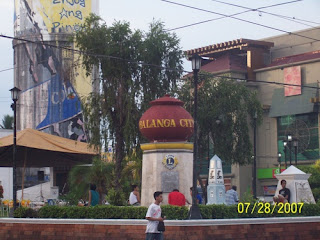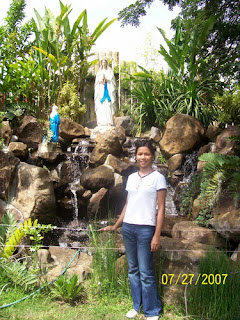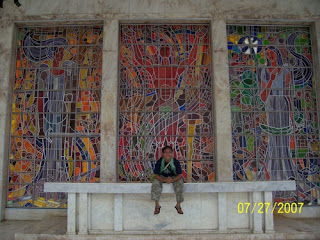A Journey to Christ: MMC 2007 Pilgrimage
This is my first time to attend a pilgrimage. Although not as grandeur as any Marian Pilgrimages held in Lourdes, France or Italy, this one is quite memorable since its the first time for SFC Conference to have one, an excellent prelude and a good preparation for my last Metro Manila Conference as SFC.
The “Pilgrims”, attended by the MMC participants, gathered just in time in front of Bataan People’s Center near the City Capitol of Balanga. A short prayer was led to level up the start of a whole day pilgrimage.
The “Pilgrims”, attended by the MMC participants, gathered just in time in front of Bataan People’s Center near the City Capitol of Balanga. A short prayer was led to level up the start of a whole day pilgrimage.

(SFC West B was instantly tapped to lead the recitation of Holy Rosary all through-out the pilgrimage)
First Stop: St. Joseph Cathedral of Balanga City
Balanga, the capital of Bataan, was formerly a visita of Abucay before it was established as a mission of the Dominican Order in the Provincial Chapter of April 21, 1714 and later declared a vicariate on April 18, 1739, under the patronage of Saint Joseph. Upon the establishment of Bataan as a separate province in 1754, Balanga was made its capital by General Pedro Manuel Arandia due to its favorable location, at the heart of the new territorial jurisdiction. The word Balanga originates from the Tagalog word bañga (clay pot), which the town used to produce and which was among the best that can be found in the country.

The spiritual ministration of Balanga formerly belonged to Abucay. Balanga became an independent missionary center in 1739. Rev. Benito Rivas, O.P., strengthened this church by fortifying its wall. Rev. Juan Antonio Vicente, O.P, roofed it with galvanized iron and decorated the interior. Rev. Mariano Ma. Minano, O.P., from 1838-1845 constructed the arch of the choir loft and made the baptismal font out of granite from Mariveles. The parochial ministration under the Filipino clergy started with Rev. Mariano Sarili, June 21, 1898. The church was used as the site for Japanese artillery bombardment of Mt. Samat where Filipino and American forces gave their last stand during the last world war.

After the Holy Mass, officiated by the Assistant Parish Priest, the first decade of Sorrowful Mystery of the Holy Rosary was led by our own brother, Kuya Budz. A short talk delivered by the CFC Family Ministry Head of Balanga City followed giving important points of following Jesus, despite of many adversities. He pointed out that, even we choose to followed Jesus in his holiness, we are not yet secured of our life, but what assures us is of Gods love for us. No one is exempted from sufferings, trials and miseries. He even cited Bishop Soc Villegas who had just endured a vehicular accident after avoiding a carabao and in the process hit a tricycle resulting to a casualty.
We had our lunch after the first stop. Others settled in the nearby fast food chains, while we walk through the inner streets of the city towards where our bus was parked, in Barangay Dona Francisca, just beside a park. It was an instant bonding session and picnic on the park as we laid down our “banig” and shared our packed lunch of sauté tuna, fried fish and pork chop with matching tuyomansi sauce.
Second Stop: St. Dominic De Guzman Church
At 12:40pm, we are on the go to the next stop, St. Dominic De Guzman Church of Abucay, Bataan.
Located in the northern part of Bataan and Pampanga, Abucay is 119 kilometers from Manila or within a 50-km. radius from Manila Bay. It has a total land area of 7,970.00 hectares, 44% of which is ideal for habitation and lowland rice cultivation and fish farming.

The name Abucay was coined from "abu-kinaykay" which means digging the debris of fire. According to legend, a Spaniard came to this town and was asking for its name. It so happened that his arrival coincided with the just extinguished big fire that burned and destroyed quite a number of houses in the place and so the people were busy digging the remains from the ashes. Digging or shoveling, "kinaykay" in local dialect. So when this Spaniard asked for the name of the place, the residents quickly replied, "abu-kinaykay", thinking that this Spaniard was asking what they were doing. From then on this town was called that way and later on to Abucay.
(414-year-old church constructed in 1587 in the rich Spanish style of the day, and a living witness to the massacre of more than 200 native defenders from the hands of Dutch invaders on June 16, 1647.)
The spiritual ministration of Abucay was entrusted to the Dominicans in 1588. Forty others, together with Spanish Alcalde mayor and two Dominican priests were taken prisoners to Batavia during the Dutch invasion. This town witnessed the courage and heroism of our countrymen who resisted against the Spaniards, the Dutch, the Americans, and the Japanese colonizers. Movable wooden press blocks was taken within the church of Abucay to be the first printing press in the country and is refuted to be older than any other single press in the United States. Tomas Pinpin, a native of Abucay ,who grew up under the tutelage of the Dominican priests in the convent, learned the rudiments of printing from Fray Francisco Blanca de San Jose and Juan de Vera, a Chinese printer at the University of Santo Tomas, where as early as 1610, they printed several books in Spanish and Tagalog. Pinpin is undoubtedly the first Filipino printer. The present church was badly damaged by the earthquake of 16 September 1852.
The second and third decades of the Holy Rosary were recited led by our own Sis. Jo and a sister from West B-1A, respectively. A short talk was delivered that centers on Gods Covenant to his people. The First Covenant of Noah given after the great flood; that he will no longer perished his people though water. The Covenant of Abraham; because of Abrahams’ offering where he is willing to sacrifice his son, God made a covenant that He will make all the descendants of Abraham leaders of great nation; the Covenant of Moses; after saving the Israelites from slavery; God gave Moses the 10 Commandments; and the Covenant of Christ; because God loves his people so much; he send out His own Son, through His own blood, that we will be save and redeemed.
Challenge was poised to all the pilgrims. If God is faithful to his promises and faithful to his covenant to us as his sons and daughters, are we faithful to our covenant to God?
Third Stop: Our Lady of Pillar Church
Pilar is found in the southeast portion of the province of Bataan. It is bounded by Orion in the South, Balanga in the North, Bagac in the west and Manila Bay in the East. It has a total land area of 3,760.00 hectares. Its terrain is gently sloping to undulating, reaching a hilly peak. The highest elevation is 553 meters at Mt. Samat in Barangay Diwa. As of 1995, the town has a population of 28,207 residing in nineteen (19) barangays. Pilar produces an ample supply of rice, corn, vegetables, rootcrops and legumes. Chicken, hogs and ducks as well as freshwater fishes are abundant in the area. Bamboo, cogon and different vines can be sourced from hilly portions of Pilar while gravel and sand is abundant in Barangay Nagwaling, Alauli, Pantingan, Diwa and Liyang.
Pilar is found in the southeast portion of the province of Bataan. It is bounded by Orion in the South, Balanga in the North, Bagac in the west and Manila Bay in the East. It has a total land area of 3,760.00 hectares. Its terrain is gently sloping to undulating, reaching a hilly peak. The highest elevation is 553 meters at Mt. Samat in Barangay Diwa. As of 1995, the town has a population of 28,207 residing in nineteen (19) barangays. Pilar produces an ample supply of rice, corn, vegetables, rootcrops and legumes. Chicken, hogs and ducks as well as freshwater fishes are abundant in the area. Bamboo, cogon and different vines can be sourced from hilly portions of Pilar while gravel and sand is abundant in Barangay Nagwaling, Alauli, Pantingan, Diwa and Liyang.
Legend of Pilar said that long ago this town was merely a barrio within the jurisdiction of the town of Balanga. There were very few inhabitants. One day a Spanish galleon was tossed to its shores by a violent storm. The galleon's destination was some town where it was to convey the image of a virgin. The Spaniards were greeted by the inhabitants were they landed. The visitors asked for the name of the place and they replied that it has no name. The Spaniards suggested that the place be named in honor of the image they had with them which was that of the "Lady of the Pillar". The people consented and since that time, the town had been called "Pilar".
The “patio” of the church was beautifully landscaped and well maintained with prayer garden. It includes life-size statue of Christ’ crucifixion and Jesus by the well with a Samaritan women. A fountain and a grotto with gushing water just beside a tall century old tree are among its prominent centerpieces.


The fourth decade of the Sorrowful Mystery was recited. The short talked delivered by a SFC FTW from Davao concentrated on two ways in living up of our covenant. By grow in love with God and grow in love with one another. Growing in love with God means listening to God and finding Him in every person that we meet; our family, our colleagues, our friends, even our enemies. Grow in love with one another means serving our brothers and sisters especially the poor.
Last Stop: Shrine of Valor
Dambana ng Kagitingan or Shrine of Valor in Mt. Samat also in Pilar, Bataan is our last stop. As we pass through the straight highway towards Mt. Samat, we could see the towering Cross on top of the mountain. We are around 20 vehicles lead by a police patrol car with motorcycled REACT volunteers facilitating the flow of the convoy.

As we trekked the winding road leading the summit of Mt. Samat, we could see almost the entire province of Bataan, its peninsula and nearby islets. The altitude of 564 meters is just enough for a bearable pressure on our ears.
(We have to pay some fees to experience this last stop: P50/ car parking fee at the Shrine of Valor, P20/ person entrance fee at the Shrine of Valor and P10/ person at the Mt. Samat Cross)
Suffering heavy losses against the Japanese all over Luzon, Filipino and American soldiers retreated to Bataan Peninsula to regroup for a last valiant but futile stand. This retreat to Bataan is part of a United States strategy known as War Plan Orange.
After fierce battle lasting 3 days, 78,000 exhausted, sick and starving men under Major General Edward P. King surrendered to the Japanese on April 9, 1942. It was, and still is, the single largest surrender of U.S. Forces ever.


After the recitation of the last decade of Sorrowful Mystery in an altar, a culmination talk and short worship capped the pilgrimage. With the subtle breeze of air, with some scent of pine tree, we are literally closer to God praising and singing songs of worship.
A long-range binocular can be rented to view the Bataan peninsula. If the sky is clear, you can see the Bataan Nuclear Power Plant in Morong, Bataan.
The altar hall is just a high ceiling structure with marbled walls engraved with the detailed history of Fall of Bataan. Just beside the altar hall is the entrance going down the war museum that has a wide array of displays from paintings of the Philippine heroes to armaments used by the American and Japanese forces during the heat of the battle.
Esplanade steps going to the summit where the Cross is located will take around 10 more minutes of brisk walking with pine trees alongside the trail. Built in 1966, this huge white cross stands as a mute but eloquent reminder of the men who died there. The foot of the cross has different murals depicting the history of great Malayan. The structure is 360 feet tall. The horizontal arms of the cross are 300 feet up and are at an altitude of 635 meters above sea level. There is an elevator that can take you to these "arms". The arms are actually viewing galleries from where you can see practically the whole east side of Bataan, Manila Bay and some portions of the west of Bataan.
It’s been almost a month now after that Pilgrimage, but still the moments and experiences that we have together with our brothers and sisters are still vivid in my memories. The fun and special bonding are just bonuses. The pilgrimage is not just like a walk down with the memory line of Bataan’s rich historical past. It is not just like a “visita iglesia” in the month of July. But it’s an opportunity to hear God’s messages through this journey. This is just a reminder of everyone’s personally journey of knowing more of God and living out with the covenant that He has given us, a covenant of faith and a covenant of His promises.
















0 Comments:
Post a Comment
<< Home